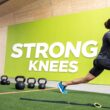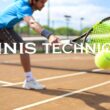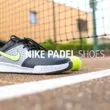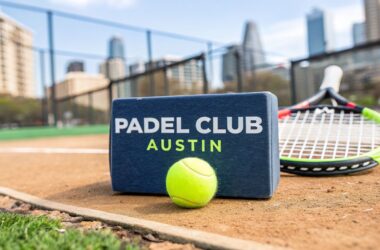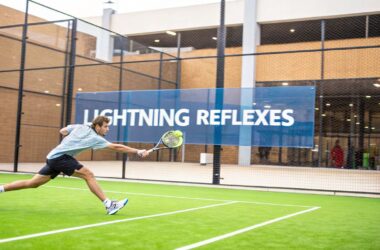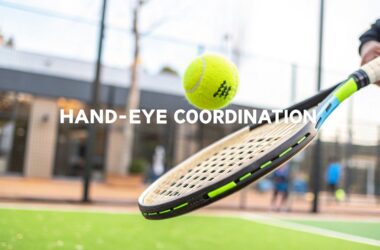When you boil it down, the core difference in the padel vs. pickleball debate is simple: padel is a fast-paced, wall-based game that feels like a high-energy mix of tennis and squash. Pickleball, on the other hand, is a more accessible, strategic game on a smaller court, where quick volleys and clever shot placement are king.
Padel vs Pickleball: A Quick Comparison
While both sports have absolutely blown up in popularity, they offer completely different on-court experiences. This all comes down to their courts, gear, and rules.
Padel, born in Mexico and now a phenomenon in Europe and beyond, is played inside an enclosed glass court. The walls aren't just boundaries; they're a key part of the game, adding a wild strategic layer. Pickleball, a classic American invention, is played on an open court much like a badminton court. The game is all about controlling the net and mastering the non-volley zone, famously known as the "kitchen."
So, which one should you choose? It really depends on your athletic background and what you're looking for. If you crave dynamic, fast rallies and have a background in sports like tennis, padel's larger court and faster pace will probably feel like a natural fit. But if you want something incredibly social that's easy for anyone to learn and play almost immediately, pickleball's smaller court and gentler learning curve are tough to beat.

Buy the best padel gear to level up your next game!
CHECK OUT this deal from Padel Market!Get ready to take your game to the next level with the latest padel gear from Padel Market! Fast EU and Worldwide Shipping
Head-to-Head Breakdown
To really get a feel for how these sports play, it helps to see their core components side-by-side. These elements dictate everything from the game's speed to the skills you'll need to master.
Here's a straightforward look at the key differences between padel and pickleball, covering everything from the court you play on to the gear in your hand.
Key Differences Between Padel and Pickleball
| Feature | Padel | Pickleball |
|---|---|---|
| Court Type | Enclosed with glass & mesh walls (20m x 10m) | Open court with no walls (13.4m x 6.1m) |
| Ball Type | Depressurized tennis-style ball | Hard plastic ball with holes (like a wiffle ball) |
| Racket/Paddle | Stringless, perforated "pala" (thicker) | Solid, stringless paddle (thinner) |
| Key Rule | Walls are in play; underhand serve after bounce | "Kitchen" non-volley zone; underhand serve |
| Scoring | Same as tennis (15, 30, 40, game) | Points scored only by the serving team (to 11) |
| Primary Skill | Power, strategy using walls, teamwork | Finesse, dinking, quick volleys at the net |
This table shows just how different the DNA of each sport is. While both are fun, social, and great exercise, the experience you'll have on the court is worlds apart.
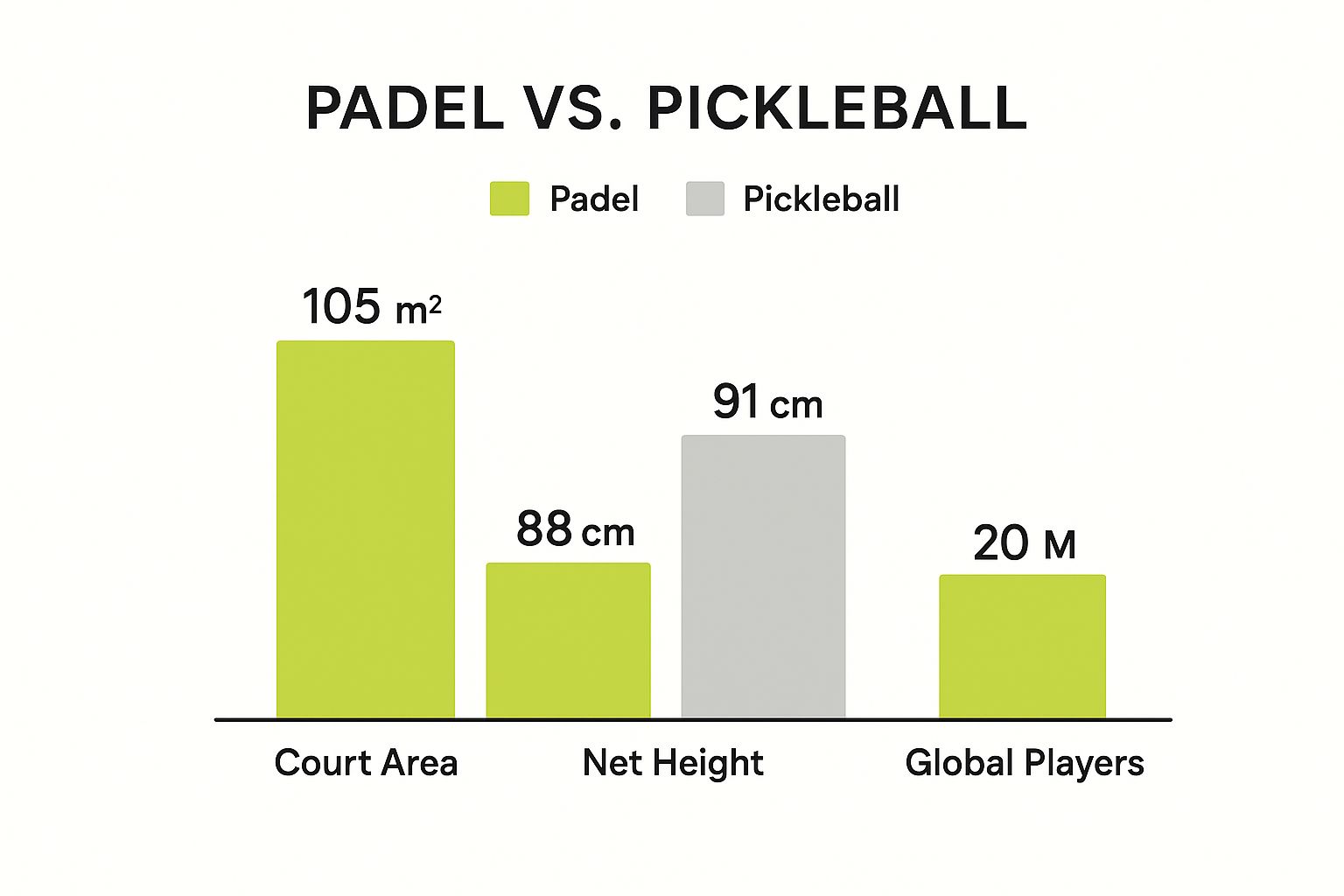
The data really drives the point home. Padel has a much larger court and a bigger global footprint, while pickleball's slightly higher net directly influences its net-focused, tactical gameplay. The numbers don't lie—though they both use a paddle and a ball, their unique environments create two fundamentally different games.
The Meteoric Rise of Two Global Sports
When you're looking at padel versus pickleball, you can't miss their explosive, yet totally different, paths to global fame. Both sports are taking over courts and winning fans at an incredible rate, but they're doing it in different parts of the world. Each one is building its own unique culture, and understanding this context is key to seeing where they're both headed.
Padel has cemented itself as a sporting giant in Europe and Latin America. It started in Mexico, but its growth has been absolutely stunning in countries like Spain and Argentina. Over there, it's not just a weekend hobby—it's a mainstream sport with pro leagues and tons of media coverage. Its social, doubles-only format has made it a community staple, which has only fueled its expansion. For the latest scoop, you can check out our section on the padel sport.
Padel's Global Expansion and Market Power
Padel's growth isn't just word-of-mouth; the numbers are seriously impressive and show its international appeal. The sport is breaking out of its traditional strongholds and making big moves in the Middle East and now, North America.
This expansion is backed by a solid infrastructure of court construction and a booming equipment market. Padel has blown up globally, now boasting 30 million players worldwide and 60,000 courts spread across 130 countries. The sport's market was valued at a cool $225 million and is expected to more than double to $493 million by 2032. That's a compound annual growth rate (CAGR) of 10.3%, proving padel's popularity is here to stay as it becomes a true global phenomenon. You can dive deeper into the market trends in this comprehensive padel and pickleball comparison.
Pickleball's Unstoppable Surge in the US
While padel was conquering Europe, pickleball kicked off a grassroots revolution right here in the United States, becoming a genuine American success story. Its real superpower is how easy it is to get into. The rules are simple, and the smaller court can be quickly set up on an existing tennis court, making the barrier to entry almost non-existent.
This accessibility has made pickleball the fastest-growing sport in the nation for several years straight. It's thriving everywhere—from community centers and retirement communities to public parks—creating a super social and inclusive vibe that appeals to every age and fitness level.
Key Insight: The growth story of padel vs. pickleball is really a tale of two continents. Padel's rise comes from its deep cultural roots in Europe and Latin America, while pickleball's explosion is a distinctly American thing, driven by how easy and community-focused it is.
Pickleball’s popularity is intensely focused on North America, with a huge player base in the U.S. and a growing scene in Canada. Its governing bodies are pushing to take the sport international, but its heartland is still firmly in the United States. This regional dominance is a major point of contrast when you stack it up against padel's broader global reach. Each sport's journey shows a different path to growth—one built on deep regional integration, the other on rapid, widespread adoption in a single massive market.
Comparing Court Design and Equipment
You can tell a lot about a sport just by looking at the arena and the gear. When it comes to padel versus pickleball, the court and equipment aren't just details—they define the entire experience. They shape the strategy, the rhythm of the rallies, and the very feel of the game from the moment you step on the court.
The Court: A Cage vs. an Open Field
The most striking difference is right under your feet. A padel court is basically a strategic cage, a 20m x 10m rectangle surrounded by glass and mesh walls. But these aren't just boundaries; they're part of the game. A ball bouncing off the back or side glass is live, creating wild angles and unexpected rebounds. It’s a game that demands 360-degree awareness.
Pickleball, on the other hand, is played on a smaller, open court measuring 13.4m x 6.1m. It looks like a miniature tennis court. This open layout forces you to focus on precise shot placement, dominating the net, and controlling the space between you and your opponent. There are no walls to bail you out of a wide shot, so accuracy is everything.

Buy the best padel gear to level up your next game!
CHECK OUT this deal from Padel Market!Get ready to take your game to the next level with the latest padel gear from Padel Market! Fast EU and Worldwide Shipping
Key Takeaway: Padel’s enclosed court makes for a game of ricochets and angles, where you can turn defense into a surprising attack. Pickleball's open court is all about precision and control—if your shot is out, it's out.
The Tools of the Game: Padel Rackets vs. Pickleball Paddles
The equipment you hold in your hand is just as different as the courts. Both sports use stringless paddles, but they’re built for completely different styles of play.
A padel racket, or "pala," is a thick, solid tool made from carbon fiber or fiberglass with holes drilled into its face. Those holes help cut down on air resistance and give you a bit more bite for spinning the ball. Its thick core is built for power, letting you hit hard drives from the back of the court and smash overheads with real authority.
A pickleball paddle is a different beast entirely. It's thinner, lighter, and has a solid, non-perforated face. These paddles are designed for touch, control, and lightning-fast reactions at the net. The core thickness is a huge deal in pickleball, usually coming in at 14mm or 16mm.
- 16mm Paddles (Thicker): These feel softer and give you more control because they absorb some of the ball's energy. They're perfect for dropping soft "dink" shots into the kitchen and for players who value placement over pure power.
- 14mm Paddles (Thinner): These offer more "pop" and power. The thinner profile lets you swing faster, enabling harder drives and counters.
This really gets to the heart of it: padel rackets are built for a power-based, rally-heavy game, while pickleball paddles are finely tuned for finesse and quick, strategic exchanges.
How the Ball Shapes the Rally
The last piece of the puzzle is the ball itself, which completely dictates the pace and bounce of the game.
A padel ball looks a lot like a tennis ball, but it's slightly smaller and has less internal pressure. This lower pressure means it doesn't bounce as high, giving players more time to get into position—essential when the ball can fly off a glass wall from any angle. This encourages longer, more strategic rallies.
A pickleball ball is a hard plastic ball with holes, similar to a wiffle ball. This design creates a lot of air drag, so it travels slower and bounces lower than a padel ball. The result is a game that's naturally less about overwhelming power and more about close-quarters net play and careful dinking.
These equipment differences even show up in market trends. In Europe, where padel is well-established, its dominance is clear. One report showed that padel racket sales crushed tennis racket sales, with over 900,000 padel rackets sold compared to just 400,000 tennis rackets in one year. You can dig into more data on equipment sales and popularity in this insightful padel and pickleball breakdown. It shows that while pickleball is growing incredibly fast, padel's infrastructure and equipment market are simply more mature on a global scale.
How Gameplay and Rules Shape the Experience
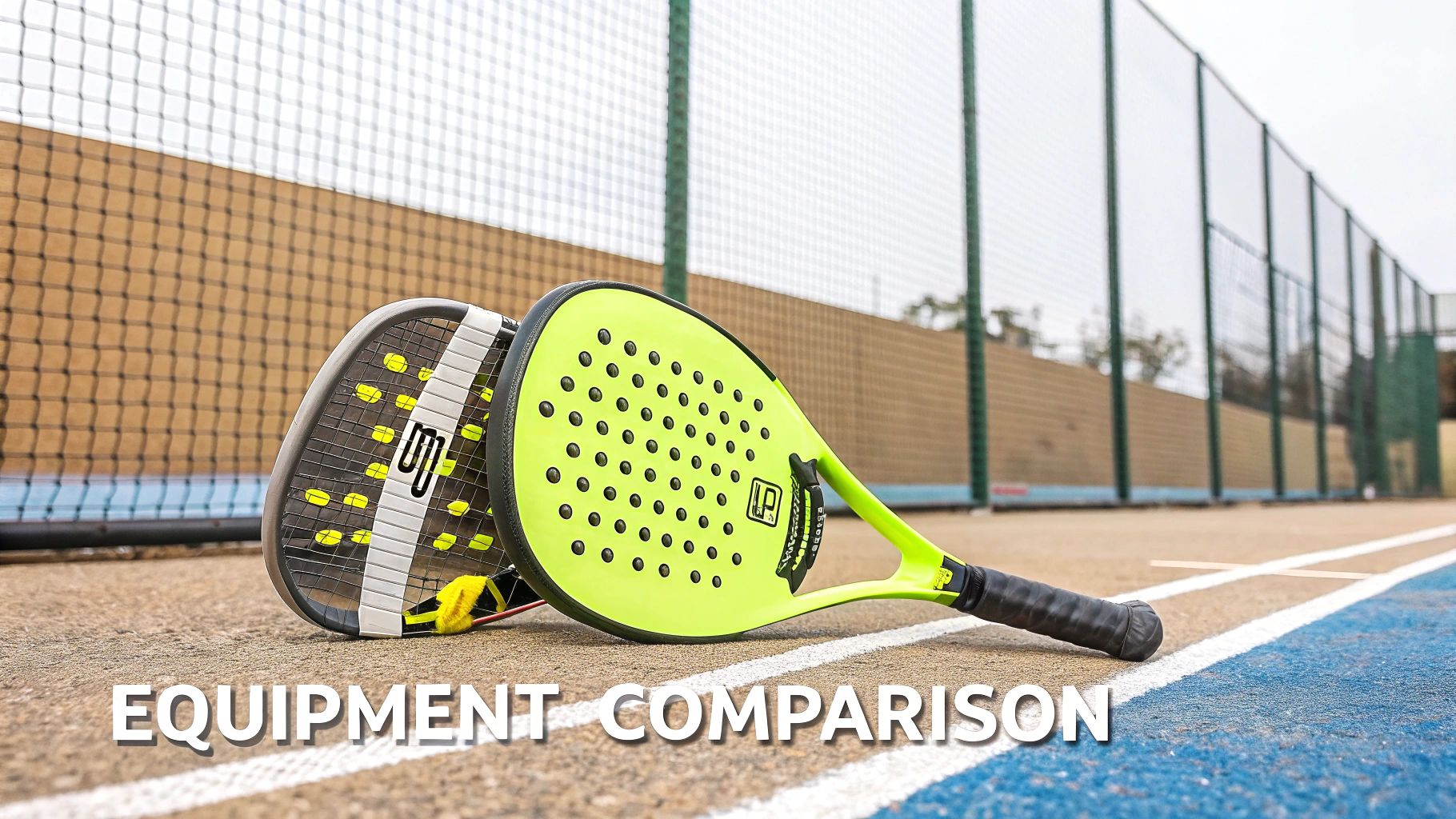
Forget the gear and court size for a second. The real heart of the padel vs pickleball debate comes down to how you actually play the game. The rulebook is what gives each sport its unique personality, dictating the flow of a rally and the strategy you’ll need to win.
Both games kick off with a serve, but their mechanics immediately show you they have different ideas about how a point should start. In both padel and pickleball, the serve must be underhand, struck at or below your waist. This is a game-changer compared to tennis. It completely takes away the blistering ace, making the return of serve a crucial part of the rally right from the get-go.
Here’s the first big split, though. Padel requires you to bounce the ball on the ground behind the service line before you hit it. This little extra step creates a predictable, rhythmic start to the point. Pickleball, on the other hand, lets you hit the serve straight out of your hand—no bounce needed. It’s a faster, more direct way to get the game going.
Strategic Zones and Wall Play
Once the serve is in, the court’s unique features dictate everything. This is where the real strategic chess match begins in both sports.
In pickleball, your world revolves around the non-volley zone, that seven-foot box on either side of the net everyone calls the "kitchen." You are absolutely not allowed to hit a volley (a ball out of the air) with your feet inside this zone. This clever rule stops players from just crowding the net and smashing everything, forcing a more delicate game of soft "dink" shots to try and force an error. To be good at pickleball, you have to be the master of the kitchen.
Padel doesn't have a kitchen. Its game-defining feature is the enclosed glass and mesh walls. The walls aren't just boundaries; they're an active part of the court. You can play a ball after it hits the back or side walls, which turns a guaranteed lost point in tennis or pickleball into a chance to reset or even launch a counter-attack. It forces you to think in 360 degrees and adds a wild, geometric element to the game.
Key Insight: Pickleball is all about horizontal control—where you are in relation to the net and the kitchen line. Padel is about both horizontal and vertical control, as the walls add a third dimension to every single rally.
Scoring Systems and Game Flow
How you rack up points also gives each sport a completely different feel, directly impacting the match's momentum and the pressure you feel.
Padel keeps things simple by borrowing its scoring system directly from tennis. You count points as 15, 30, 40, and game, complete with "deuce" and "advantage" to settle tight games. If you've ever watched or played tennis, you'll feel right at home. It creates a familiar rhythm of tension and release. For a closer look at these similarities, check out this breakdown of padel tennis.
Pickleball throws that system out the window for side-out scoring. Here, only the serving team can score a point. Games are played to 11 points (win by two). So, if you're the receiving team and you win a great rally, you don't get a point—you just win the serve. This can lead to long, tense battles where no one scores, putting immense pressure on your ability to hold serve.
To make it crystal clear, let's break down these core differences.
Rule and Gameplay Comparison
The table below highlights the fundamental mechanics that define how a point is played in padel versus pickleball. These rules are small on paper but create massive differences on the court.
| Gameplay Element | Padel | Pickleball |
|---|---|---|
| The Serve | Underhand, but must bounce the ball first. | Underhand, hit directly out of the hand. |
| Key Zone | The entire court, with walls in play. | The "kitchen" (non-volley zone) at the net. |
| Scoring Method | Tennis scoring (15, 30, 40, game). | Side-out scoring, points only on serve (to 11). |
Ultimately, these rules guarantee that even though both sports are incredibly fun, the skills needed to succeed are worlds apart. One game rewards you for patience and precision near the net, while the other celebrates dynamic movement and creatively using the walls to your advantage.
So, Which One Is Right For You?
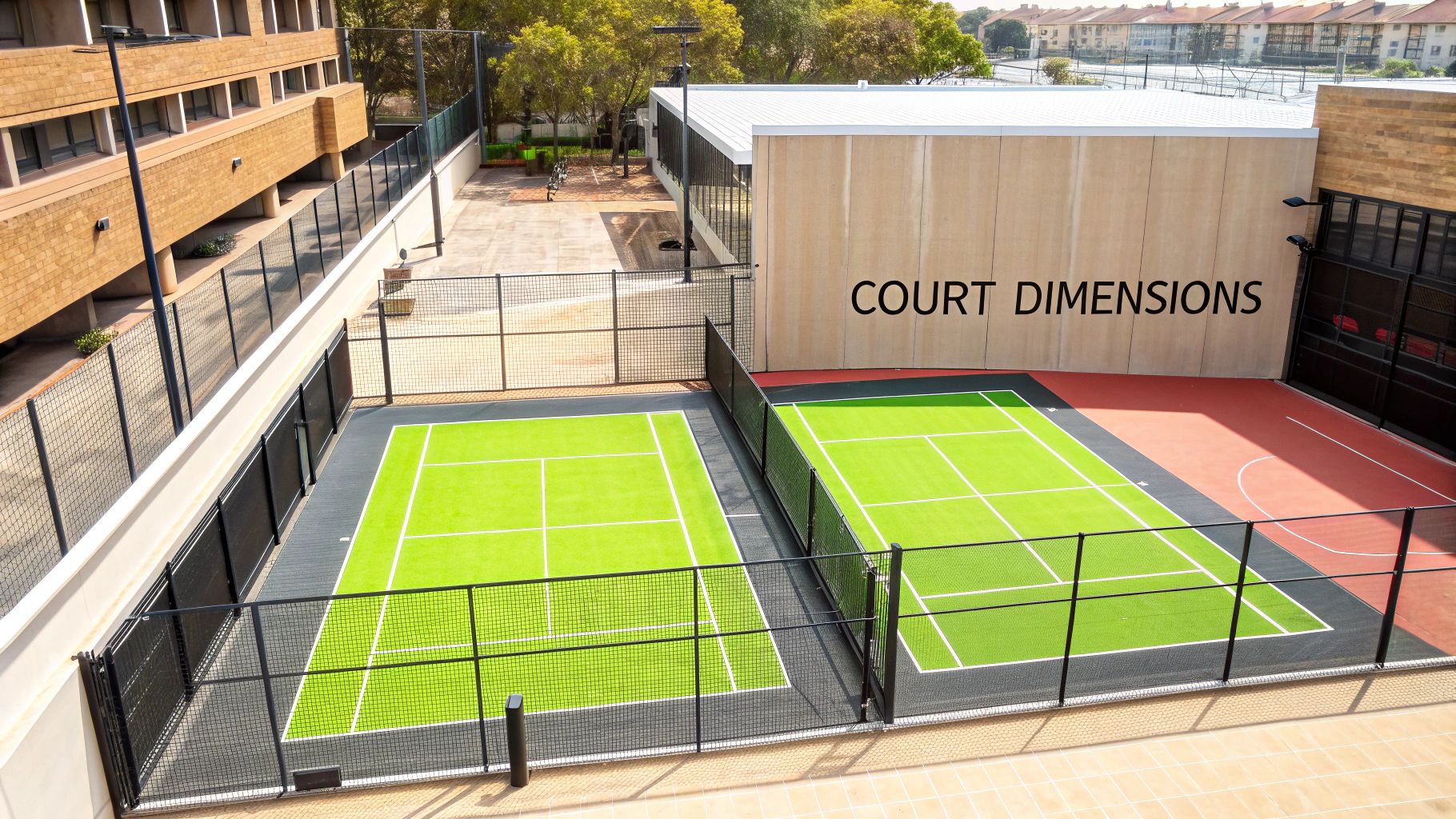
Choosing between padel and pickleball isn't just about the rules or the gear. It really comes down to what you're looking for in a sport. Are you after a casual, social game or a more athletic, strategic battle? Your personal style, fitness goals, and even what you want out of your social life will point you to the right court.
Who Should Choose Pickleball?
If your main goal is finding a super social, easy-to-learn game you can play with just about anyone, pickleball is a fantastic choice. The court is smaller, the ball moves slower, and the learning curve is incredibly gentle. Seriously, most beginners can be holding a fun rally within their first hour.
This immediate playability makes pickleball perfect for casual get-togethers and family gatherings where you have a mix of ages and skill levels. Players are close together, which naturally sparks conversation and makes it as much a social hangout as it is a sport.
You’re a great candidate for pickleball if:
- You’re a total newcomer to racket sports.
- You’re looking for a highly social game to play with a diverse group.
- You’d prefer a less physically demanding sport that’s easier on the joints but still a good workout.
- You love the strategic finesse of a well-placed "dink" more than raw power.
Its wild popularity in the United States is proof of how accessible it is. Pickleball is a true phenomenon, with an estimated 36.5 million players in the U.S. alone. The sport has seen a mind-blowing 158.6% average growth in participation over the last three years, largely because it appeals to so many people.
Who Should Choose Padel?
On the flip side, if you're craving a more dynamic and athletic challenge that blends tennis-like power with squash-like strategy, padel is calling your name.
The larger court means you'll be covering more ground, and learning to use the glass walls adds a whole new layer of strategy that’s incredibly rewarding to master. Padel is faster, the rallies can be epic, and the teamwork in doubles is non-negotiable. To see what top-tier strategy looks like, you can follow the latest padel news and watch the pros.
The Bottom Line: Pickleball is your go-to for social, accessible fun that anyone can start playing right away. Padel is for those who want a more athletic, tennis-like experience with a uniquely strategic twist.
Think about where you're coming from. Tennis players often find padel to be a natural next step. The court coverage and shot mechanics feel familiar, and while the underhand serve takes some getting used to, the volleys and power strokes translate beautifully.
Meanwhile, players with a background in sports like badminton or table tennis might feel right at home with pickleball, where quick reflexes and precise net play are king.
Let’s boil it down.
You should choose padel if…
- You have a tennis background and love hitting powerful groundstrokes and volleys.
- You want a serious cardio workout with fast-paced, dynamic movement.
- The idea of using walls to create clever angles and extend rallies excites you.
- You enjoy the deep strategy that comes with a doubles-only game.
You should choose pickleball if…
- You want a sport with a very short learning curve so you can play right away.
- Your priority is a fun, social activity for all ages and fitness levels.
- You prefer a game of touch, precision, and cat-and-mouse strategy over pure power.
- You need a lower-impact sport that’s a bit kinder to your knees and joints.
Of course, the best way to settle the debate is to get out there and try both. See which sport’s rhythm, pace, and community feels like the right fit for you.
Frequently Asked Questions About Padel and Pickleball
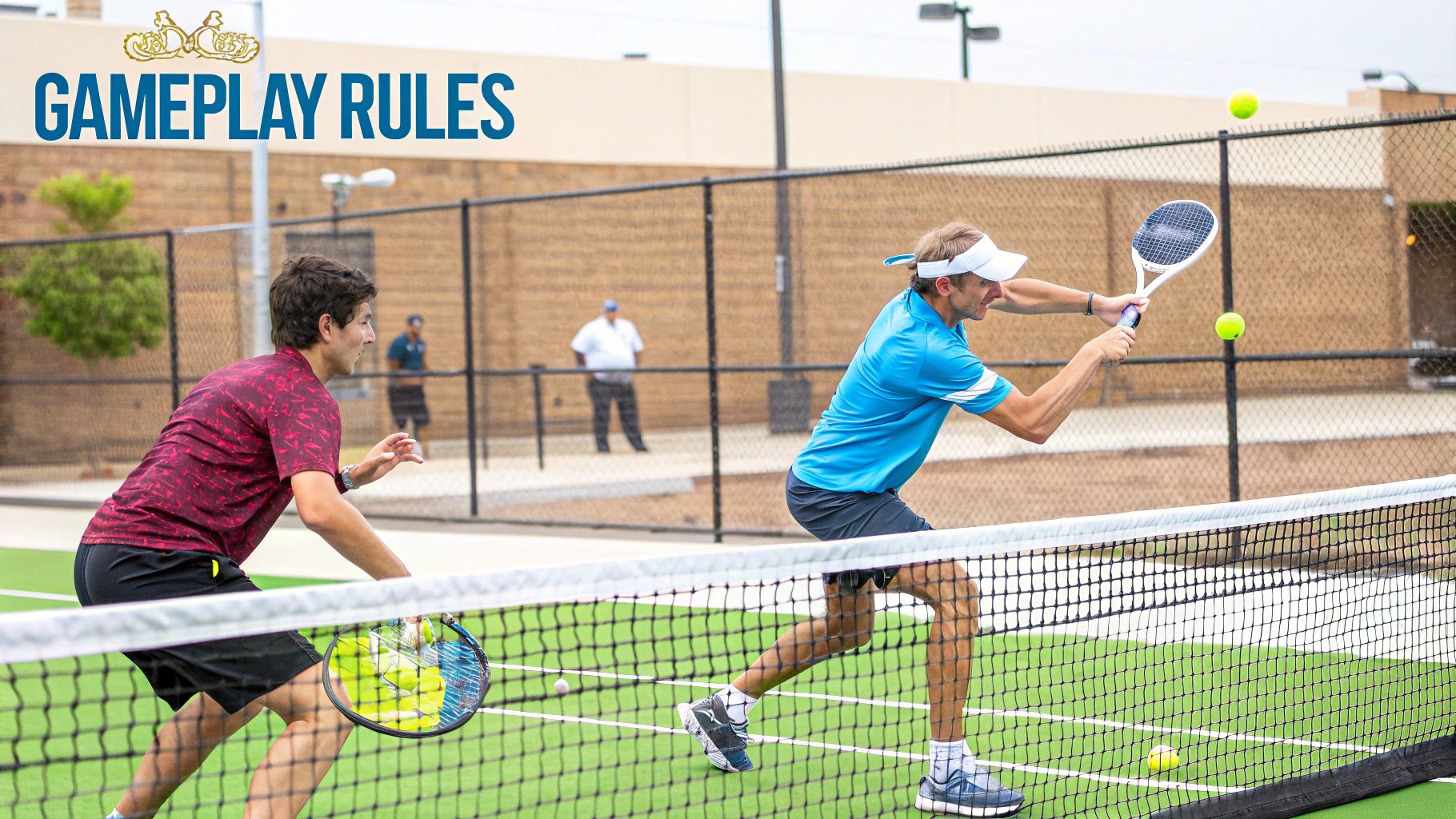
Even after breaking down the courts, rules, and gameplay, you probably still have some real-world questions buzzing around. This section gets right into the most common queries that come up when people are trying to decide between padel vs pickleball.
We'll tackle the practical stuff—from how much it'll cost you to get started to what kind of physical toll each sport might take. Think of this as the final layer of detail you need to make a choice that genuinely fits your budget, fitness, and lifestyle.
Which Sport Is More Expensive to Start Playing?
When it comes to your wallet, pickleball almost always has the advantage for newcomers. The startup costs are just plain lower, making it an easier sport to dip your toes into without a big financial commitment.
For starters, pickleball paddles are generally cheaper than padel rackets. But the real game-changer is court access. Pickleball's massive growth means many communities have converted public tennis courts into pickleball courts, so you can often find a place to play for free or for a very low fee.
Padel, on the other hand, demands a purpose-built court with glass walls and fencing. These are complex, pricey structures that are far less common (especially in the US) and are usually found in private clubs. That means you're looking at court rental fees or a club membership right off the bat. While a top-of-the-line padel racket costs more than a high-end pickleball paddle, the biggest cost barrier for beginners is simply getting on a court.
Is Padel or Pickleball Better for a Beginner?
If you're walking in with zero racket sport experience, pickleball is hands-down the easier entry point. The sport almost feels like it was designed to get new players having fun from the very first minute.
The court is smaller, so you're not running nearly as much. The plastic ball moves slower and is less intimidating, and the underhand serve is incredibly easy to learn. It's not uncommon for a total novice to be holding a decent rally within their first hour of playing—that gentle learning curve is a massive part of its appeal.
Padel is definitely easier to pick up than tennis, but it throws more technical skills at you from the get-go. Learning to use the walls, understanding the tricky angles, and handling a faster ball all take time. For a true beginner who wants immediate fun and social play, pickleball is the recommended starting point.
What Are the Common Injuries in Each Sport?
Both sports are much kinder to the body than high-impact games like tennis or squash, but they each have their own risk profile. Knowing what to look out for can help you stay healthy and on the court.
In pickleball, the quick, sharp side-to-side movements can cause lower-body problems. Ankle sprains and muscle strains are pretty common, especially if you haven't warmed up properly or are wearing the wrong shoes. The repetitive motions can also lead to "pickleball elbow"—a type of tendonitis—and wrist strains from all the dinking and volleying.
Padel’s injuries are a bit different, mostly due to its dynamic, rotational nature.
- Knee and Lower Back Strain: The constant twisting and turning to play shots off the glass can really put a strain on your knees and lower back.
- Shoulder and Elbow Issues: While not as common as in tennis, powerful smashes and the signature "bandeja" shot can tax the shoulder and elbow if your form isn't solid.
- Impact Injuries: It’s a fast-paced game in an enclosed space. Collisions with the walls or even your partner are possible, though thankfully they are rare.
The bottom line for both? Prevention is everything. A good warm-up, proper court shoes, and focusing on technique will dramatically cut your risk of injury.
Which Sport Should a Good Tennis Player Choose?
Tennis players bring a fantastic set of skills to either sport, but the best fit will depend entirely on what part of tennis they love most. Your skills will definitely transfer, but in very different ways.
If you're a tennis player who thrives on tactical net play—the quick volleys, soft hands, and cat-and-mouse game up close—you will absolutely fall for pickleball. The whole "kitchen" dynamic is a direct parallel to the finesse and control needed for high-level doubles in tennis. The dinking game will feel like a natural extension of your drop volleys.
On the flip side, if you're a tennis player who lives for the rhythm of powerful groundstrokes and loves constructing points from the baseline, padel will feel more like home. Padel is like a familiar cousin to tennis, just with walls thrown in. The game rewards powerful drives and all-court strategy in a way that feels very similar to a tennis rally. The underhand serve is the main adjustment, but the flow of a point is much closer to tennis than pickleball.
It really boils down to this: Do you prefer the strategic finesse of a net battle or the athletic power of a full-court rally?
At Padel Rumors, we're your ultimate resource for everything padel. Whether you're a beginner searching for guides, an experienced player looking for the best gear, or an entrepreneur planning to build a court, we have you covered. Explore tournament news, player profiles, and in-depth buying advice at Padel Rumors.



